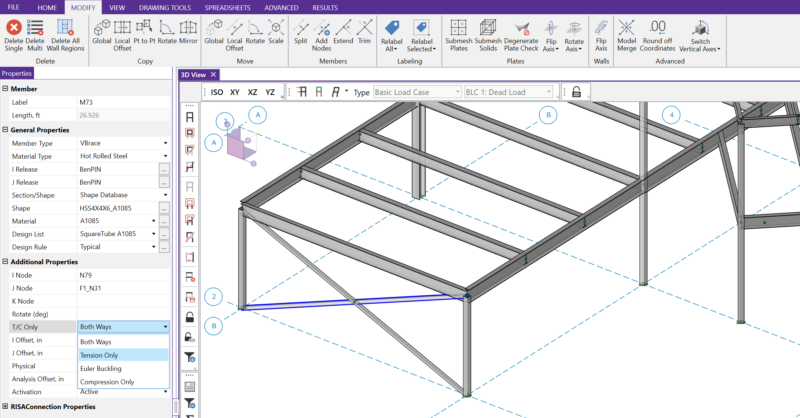Products
Learn
Support
Company
Tension or Compression (T/C) Only members are commonly used in steel buildings when modeling braced frames that resist lateral load.
Note: Tension or Compression Only Members can also be used in modeling cables or construction gaps. Detailed discussions on these applications can be found here:
Link: Gap
As a result, tension only members will only be able to take tension loads and have no stiffness to resist compressive forces. In the same way, compression only members will have no stiffness to resist tensile loads and therefore can only take compressive forces.
An important step in solving models with T/C only members is to determine the ON and OFF status of the T/C only members. For example, if a tension only member sees compression, the program removes the member from the model and updates the stiffness matrix. It then resolves the model and checks the updated status of T/C only members again. Multiple iterations (trial and error) may be needed to find the correct state of the model. The final solution is reached when the status of all T/C only members stay unchanged during the iterations.
In certain complex or unusual cases, engineers using tension or compression only members experience unrealistic behavior or issues of model convergence based on the fact that no member in real-life is truly tension or compression only. RISA-3D v17.0.3 aims to solve these issues while also providing engineers with more in-depth information about how the software is utilizing tension or compression only members.
During the solution, it is possible that the program cannot find convergence during the iterations and therefore, it could be difficult to understand or diagnose the cause, especially for complex structures. In many cases, this is because the status of T/C only members are not visually obvious. Ultimately, this could be because either the program cannot identify the converged status of all T/C only members, or the model is unstable after removing T/C only members that exceed their limit state.
In RISA-3D, when a stable solution is not achieved, the program will display new, helpful warning messages, depending on the model assumptions and potential solution.

These warning messages inform the user of the load combination and member that is having trouble converging and in order to find a solution, changes the members so that they take both tension and compression loading. This additional information provides a more direct evaluation of the members that are causing convergence issues within the model, eliminating the guesswork and allowing for a more accurate solution.
For more information on Tension and Compression only members visit the RISA Web Help section on:
